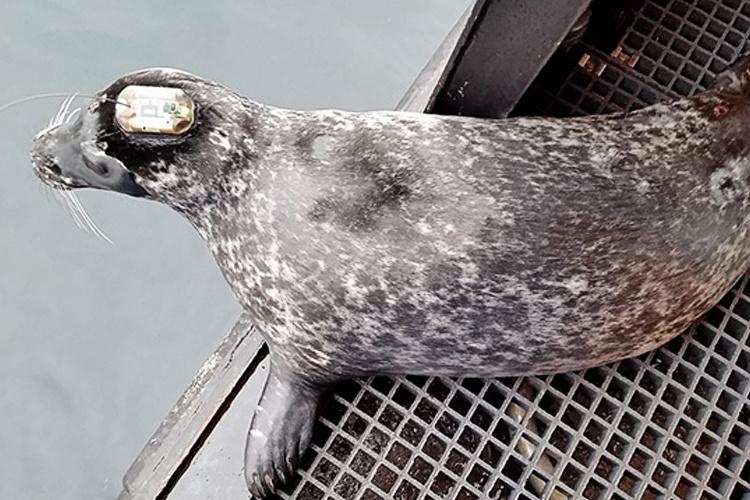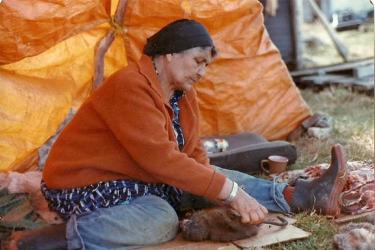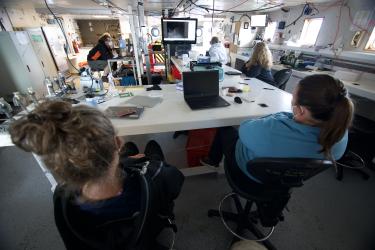A tagged harbor seal pauses at the exit before departing the R/V Norseman.
Yesterday was the last day of our harbor seal research cruise and we had just captured our second seal of the day. This seal, a juvenile female, was a good candidate to receive the last set of LHX tags we had brought along, and one more seal would mean our last head-mounted satellite tag could be deployed. Thirty minutes later, a curious seal came close to our tangle net. I stood up in our boat, yelled, “boo” and waved my arms which surprised the seal enough to turn it toward our net. “We got it!” Our third seal of the day and 35th of the trip.

Loading the final captured harbor seal aboard the R/V Norseman.
Our project got off to a fast start when we caught 10 seals in Clam Lagoon, Adak Island, on our first day of fieldwork. After tagging, sampling, and releasing 10 seals, there are a lot of samples to process; we didn’t finish until 2:00 AM so welcomed the rest during our long transit to Attu Island over the following 2 days. We caught 4 seals in Massacre Bay during our first day at Attu, and 4 more the next day. Then strong winds and high swells forced us to seek shelter in Holtz Bay for 3 days. After the storm passed, we returned to Massacre Bay and caught 3 more seals. Even though we were having a lot of success at Attu Island, we decided to move to Alaid Island next since sampling and tagging seals at a variety of locations was one of our project’s goals. We caught 4 seals on each of the next 2 days at Alaid Island, bringing our total up to 30 seals. Already this was far more successful than we could have hoped for, and we were starting to run low on our supply of satellite and LHX tags, so we decided to start working our way back towards Adak where our research cruise would end. We examined a few haul-out sites at Amchitka Island but determined that our chances of catching seals were too low, so continued on to Sea Otter Pass near Kavalga Island where we caught two more seals over the next 2 days. We attempted to capture at two haul-out sites on Tanaga Island next but dense kelp beds, shallow reefs, challenging weather conditions, and clever seals combined to thwart our plans. We moved to Kanaga Island the following day but strong winds again kept us on the ship. Thankfully the winds subsided on our last day for field work and we found the perfect little cove on the west side of Adak Island to capture our final 3 seals.
Our total catch of 35 seals included 19 males and 16 females, and by age-class was 14 adults, 14 juveniles, and 7 weaned pups. In addition to collecting hundreds of biological samples, we deployed 35 head or back-mounted satellite tags, 32 flipper-mounted satellite tags, and 10 sets of surgically-implanted LHX tags. All of the seals appeared to be in good health when they were released, and so far, are behaving normally based on early satellite telemetry results. This was the first time harbor seals have been sampled and tagged in the western Aleutian Islands and the first time LHX tags have been implanted in wild harbor seals anywhere. By any of these measures, this was a very successful project, meeting our most optimistic goals and far exceeding our expectations!

Research team from left to right: Gavin Brady (AFSC, NOAA), Jennifer Rego (SeaWorld, San Diego), Heather Ziel (AFSC, NOAA), Shawn Dahle (AFSC, NOAA), Renae Sattler (Alaska SeaLife Center), Peter Boveng (AFSC, NOAA), Stacy DiRocco (SeaWorld, Orlando), Josh London (AFSC, NOAA), Jay Ver Hoef (AFSC, NOAA), Pam Tuomi (Alaska SeaLife Center), John Jansen (AFSC, NOAA), and Markus Horning (Alaska SeaLife Center).
Now it’s time to clean and pack our field gear and head back home. In the coming weeks and months, we will monitor the seals’ movement, dive, and haul-out behaviors via data that is being transmitted by the satellite tags. Our colleagues from the Alaska SeaLife Center will also be waiting to hear back from the LHX tags, which will only transmit after the seals have died, so hopefully, we don’t hear from them for a good long while. Biological samples will be sent to collaborators for various health and genetic analyses or archived for future use, and we will prepare reports and presentations to share our results with other researchers and the public.
Finally, I want to thank each member of our field team, including the Captain and crew of the R/V Norseman, for their help and support in making this project a huge success. It was a pleasure working and sailing with you all, and I hope we have the opportunity to do it again soon!
Meet the Bloggers

Shawn Dahle
Shawn Dahle is a biologist at the Alaska Fisheries Science Center’s Marine Mammal Laboratory. Shawn joined the Lab's Polar Ecosystems Program in 2002 after completing his M.S. in Fisheries Conservation at the University of Minnesota. His research focuses on population monitoring and status assessments of seals in Alaska.

Josh London
Josh London is a wildlife biologist at the Alaska Fisheries Science Center’s Marine Mammal Laboratory. He focuses on population assessment and ecology of harbor seals and ice seals. Josh received a B.S. and Ph.D. from the University of Washington.

Peter Boveng
Peter Boveng is the leader of the Polar Ecosystems Program for research on harbor seals and ice-associated (ringed, bearded, spotted, and ribbon) seals in Alaska. His primary research interests are in the estimation of fundamental quantities for population assessment, such as abundance, trends, and vital rates, and in satellite telemetry studies of movements, distribution, and foraging behavior. Peter received Ph.D. and M.S. degrees in biology from Montana State University and a B.A. from Cornell University.

Heather Ziel
Heather Ziel is a research biologist at the Alaska Fisheries Science Center's Marine Mammal Laboratory. She works in the Lab's Polar Ecosystems Program.


